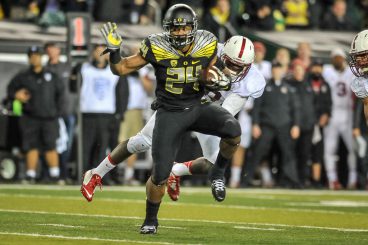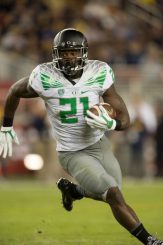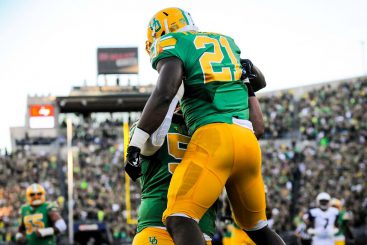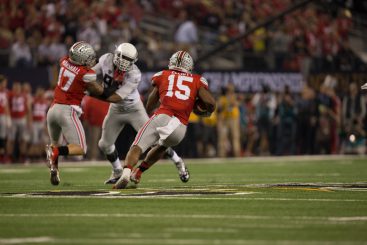Over the past three years, Marcus Mariota made it easy to forget that Oregon football’s modern identity heavily revolves around a dominant running game. The Ducks have provided college football fans with some of the most explosive ground attacks in recent memory, featuring a long line of star backs.
Although you could argue that there are two or three future NFL studs in Oregon’s current backfield, the next in line appears to be Royce Freeman. Fellow running back Thomas Tyner’s unfortunate injury has put him on the sideline for the entire 2015 season. With Tyner’s injury and Mariota moving on to the NFL, it will be Freeman who shoulders the load on offense in 2015.
At 230 lbs, Freeman provides the Ducks with the kind of power that they haven’t had since the likes of Jonathan Stewart and LeGarrette Blount. As a true freshman, he ran for 1,365 yards and 18 touchdowns, emerging as one of college football’s elite young players.
With all of that success in one year and an increased workload on the horizon, it seemed inevitable that Freeman would be mentioned in every Heisman Trophy conversation heading into 2015.
Freeman has been left off of numerous Heisman watch lists this preseason, and it has become clear that he is not exactly included among the frontrunners. The first tier of running back contenders seems to be Leonard Fournette from LSU, Ezekiel Elliot from Ohio State, Derrick Henry from Alabama, Samaje Perine from Oklahoma, and Nick Chubb from Georgia. Many seem to think that Freeman is close to this group, but still on the outside looking in.
I should make it clear here that all of the running backs listed above are phenomenal talents and each is deserving of their preseason hype. It just seems odd that Freeman, given his numbers and talent, would largely be excluded from that grouping.
Out of curiosity, I examined the numbers of Melvin Gordon, LaMichael James, Toby Gerhart, Mark Ingram and Montee Ball. Each of these players was a Heisman Trophy finalist between 2009 and 2014 (Ingram was the only winner, back in 2009). It becomes clear when comparing their numbers from the season before their respective trips to New York to this year’s batch of candidates that Freeman deserves to be in the conversation as much as anybody.
The one element that stands out as universally important heading into a Heisman campaign is consistency. Because of the wide range of volume in total numbers for all of these players, the following consistency metrics are based on the standard deviation of each player’s average rushing yards per game as a percentage of average rushing yards per game. The lower the consistency percentage, the lower the deviation and therefore the higher the consistency. It should also be noted that the statistics below do not include any outlying games where the players recorded fewer than 10 carries.
Each of those former finalists posted a consistency percentage of .35 or lower during the season before their Heisman runs, demonstrating its importance. Of the six running backs mentioned above heading into 2015 as candidates, only Freeman (.301) and Fournette (.339) boast a deviation that small. In fact, the next closest is Henry at .402, and Perine climbed all the way up to .697, thanks in large part to his record-breaking performance against Kansas.
Another good measure of consistency is the percentage of the player’s rushing total that came from his three best games. If that percentage is notably out of proportion, it indicates that most of their performances were not at the level that their averages may suggest.
Aside from Ball, each former finalist recorded less than 40 percent of their total rushing yardage in their top three games. Only Freeman, Henry and Elliot meet that requirement heading into 2015.
Strength of opponent and competition provides another great measure for success. One would expect an average back to perform better against worse competition and more poorly against better competition. However, the great backs are usually able to overcome this, remaining consistent regardless of level of competition or playing their best in big games.
To measure this, I took the correlation of each player’s individual performances compared to each opponent’s rushing yards allowed average. Correlation is measured on a scale of -1 to 1. It would be implied that the closer to one the correlation is, the more the back relied on weak competition for his production, while a negative correlation would indicate better performance against the best teams. A correlation close to zero marks no notable pattern between performance and competition.
James (-.147), Ingram (-.364), and Ball (-.474) all played against relatively tough schedules, and each recorded small or medium negative correlations. Gerhart (.64) and Gordon (.45), on the other hand, recorded higher positive correlations.
While there is less of a pattern here, good performance against tough competition is still a great measure of talent, and Freeman’s correlation of -.14 puts him in good company. Elliot (-.42) and Chubb (-.57) also both had strong negative correlations, Chubb largely because of a 266-yard outburst against Louisville’s stout rushing defense and Elliot thanks to a dominant postseason against top teams.
One aspect where Freeman does fall behind the group a bit here is in terms of his yards per carry average (5.42). However, the strength of the schedule he played against could account for that. Of all six candidates heading into 2015, Freeman, with eight, faced the most teams that finished among the nation’s Top 50 in rushing defense. Henry, with seven, was the only other back to face more than six teams meeting that criterion.
Clearly Freeman is on the right track for big things. Interestingly, his stats appear to be the most comparable to those of James, the former Duck, heading into 2015. The big back’s numbers put him in good company, and he will offer some certainty and consistency to an offense with an enormous question mark this season.
Top Photo by Craig Strobeck
Related Articles:
Joey Holland graduated from the University of Oregon in 2013, majoring in History. He played several sports in high school, though football remains his passion. He has yet to miss a single Oregon Ducks home football game during his time in Eugene. Joey has written previously for Bleacher Report and Football Nation.
Joey welcomes your feedback.





